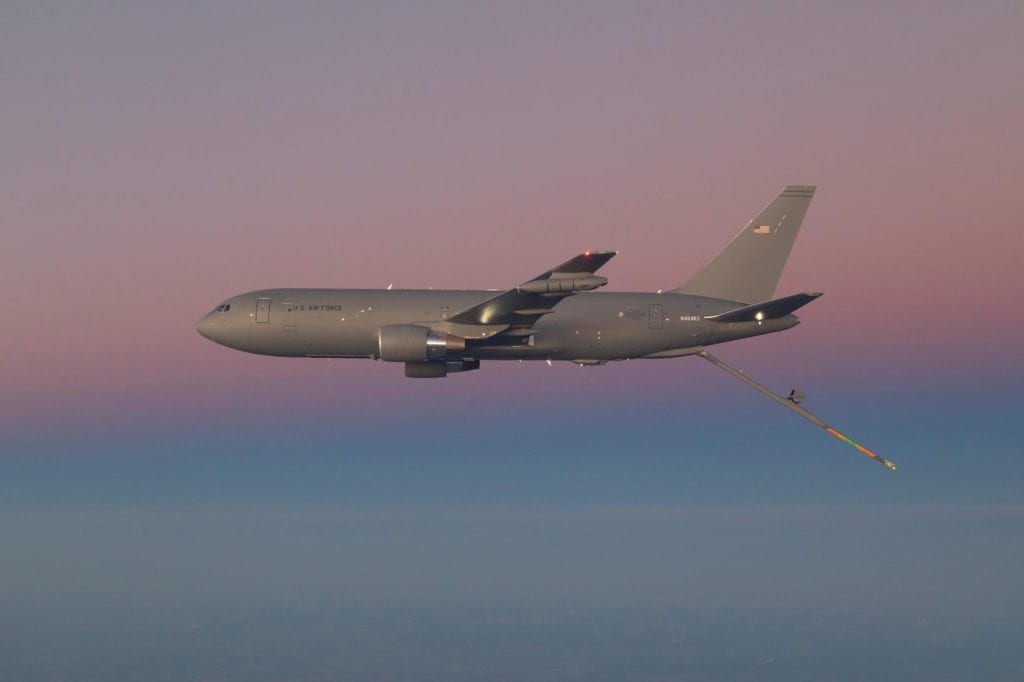
Boeing is negotiating terms for a potential communications upgrade to the KC-46A that could occur early next year. (Boeing)
The U.S. Air Force and Boeing are negotiating the terms of a contract for Pegasus Combat Capability (PC2) Block I for the company’s KC-46 Pegasus air refueler–a contract which could come in the first quarter of next year and which would provide the tanker with communications upgrades.
Boeing said that it has delivered 38 KC-46s to the Air Force thus far–21 of a planned 36 for McConnell AFB, Kan., which is to be a “super tanker base”; six of 7 for Altus AFB, Okla., the tanker training base; seven for Pease Air National Guard Base, N.H.; and four of a planned 12 for Seymour Johnson AFB, N.C.
Mike Hafer, Boeing’s KC-46 global sales and marketing manager, said that the Block I PC2 upgrade includes four radios, including government furnished equipment, and those compatible with DoD’s Mobile User Objective System (MUOS) and NATO’s Second Generation Anti Jam Tactical UHF Radio (SATURN) communications networks.
Under PC2, Air Mobility Command (AMC) is envisioning a two- to four-year successive block upgrade program for the KC-46 to encompass enhanced communications, survivability, and greater autonomy for the refueling system.
Boeing has outlined a number of fixes for the KC-46 Remote Vision System (RVS), which allows air refueling operator station (AROS) personnel in the front of KC-46A aircraft to steer refueling booms using Collins Aerospace [RTX] cameras on the fuselage. The KC-135, first fielded in 1957, and the KC-10 rely upon boom operators lying on their stomachs in the aircraft empennage to steer the booms into refueling receptacles.
The RVS cameras for the KC-46 have faced problems with sunlight glare and providing correct depth perception for accurate boom placement in refueling receptacles. Inaccurate boom placement could lead to scraping and coating damage on aircraft being refueled, such as the Lockheed Martin F-22 and F-35 stealth fighters.
Boeing and Collins Aerospace are working to resolve such difficulties with the RVS 2.0 upgrade.
Hafer said that Boeing signed a Memorandum of Agreement (MoA) with the Air Force in April under which Boeing engineers and those from the Air Force Research Laboratory (AFRL) are planning “a complete refresh of the entire Remote Vision System,” including interim steps on the way to RVS 2.0.
“We’ve been flight testing some new enhancements,” Hafer said. “We just completed at the end of July or early August the first set of flight tests, which work on dynamic image stability.”
Such flight tested hardware and software improvements eliminate “most” of the shadows and glare, he said, adding that Air Mobility Commander Gen. Jacqueline Van Ovost and Robert Behler, the Pentagon’s Director of Operational Test & Evaluation (DOT&E), recently visited Boeing “to look at some of those improvements and where we’re headed with RVS 2.0.”
Boeing has also proposed a new LIDAR sensor that provides information about the distance between the boom and the receiver aircraft, as boom operators have said that they need to judge depth “to the inch or sub-inch level,” Hafer said.
This article was first published in Defense Daily, a sister publication to Avionics. It has been edited. To read the full version, click here.